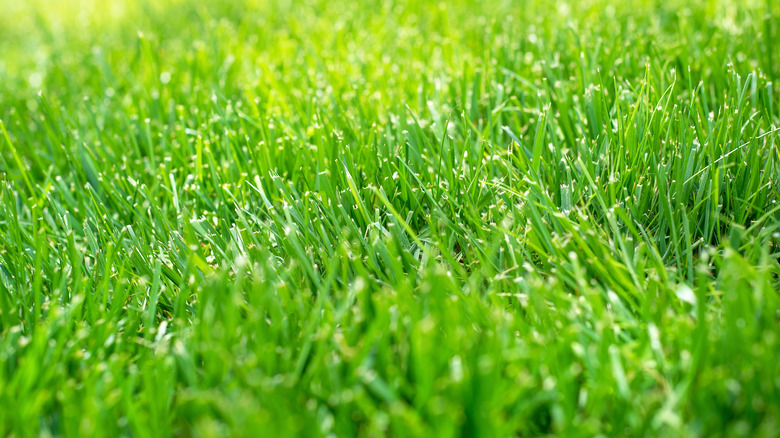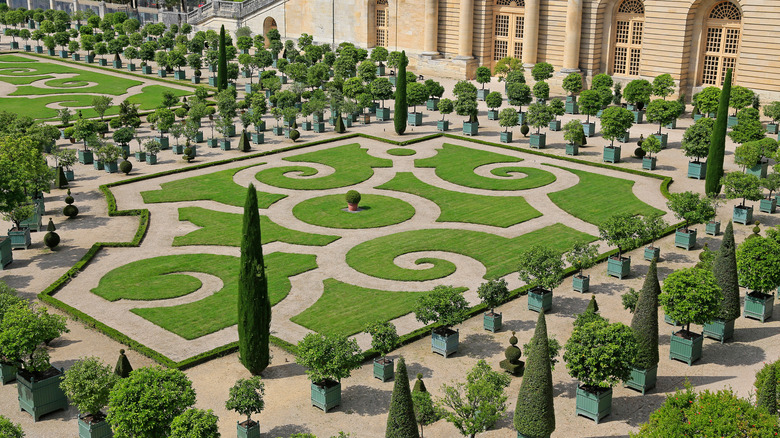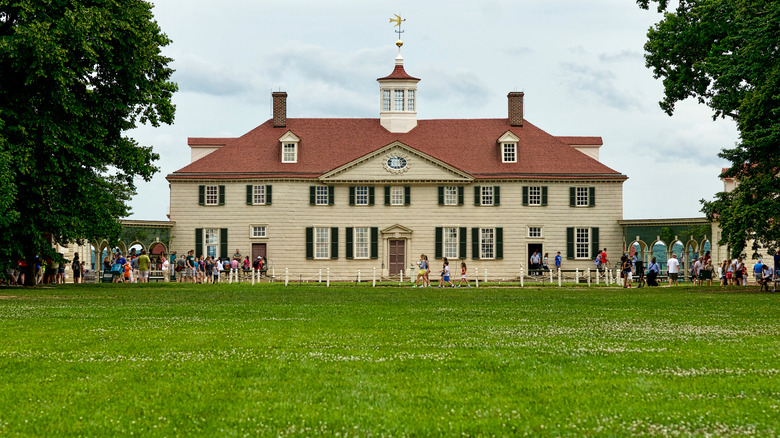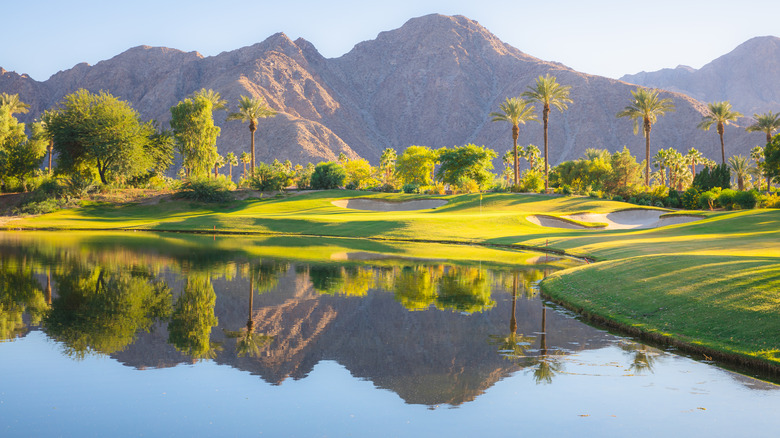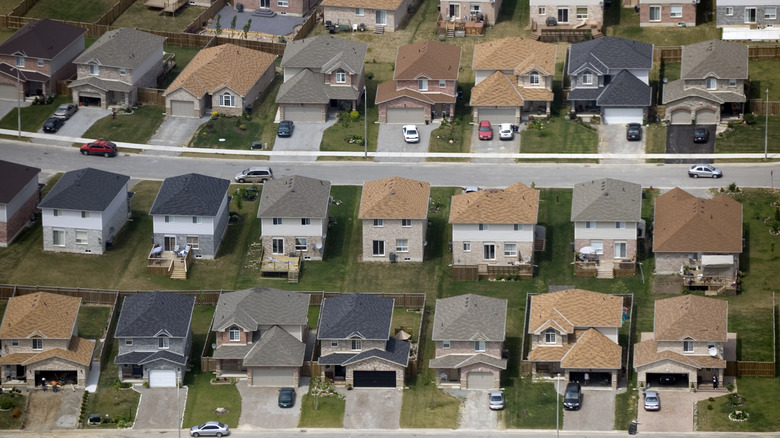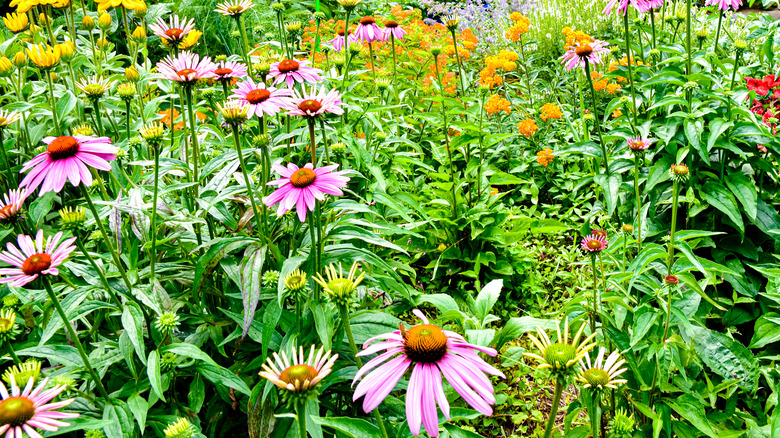The Surprising History Of Grass Lawns
Lawns are inedible and serve little practical purpose. Yet, grass is the largest crop in the United States, reports Scientific American. The time, money, and resources Americans spend on maintaining our pristine green expanses indicate that lawns hold immense cultural value. For many, lawns represent organized society itself. "When smiling lawns and tasteful cottages begin to embellish a country," the early American landscaper Andrew Jackson Downing wrote, "we know that order and culture are established" (via The Atlantic).
A home surrounded by a neatly-trimmed and well-maintained lawn has been, for some, an emblem of success (per Scientific American). But lawns are expensive. Americans spend $105 billion on lawn care each year, and roughly half of household water goes to keeping lawns alive, reports the Washington Post. That's approximately 200 gallons of drinking water a day per person. Worse, they're devastating to biodiversity and natural ecosystems.
Even if you can afford to purchase property, grass is unruly, and upkeep takes time, energy, and money. Because of that, lawns serve as quick visual cues for socio-economic status and even lawfulness. In fact, in Fairfax County, Virginia, you can report someone who "doesn't seem to care" about their lawn. Some local governments go as far as to jail residents for the state of their lawns, as was the case of Joe Prudente of Florida and Rick Yoes of Texas, writes the Atlantic. Lawns have come to reflect American values in their contradictions and reliance on appearances.
Early lawns: from survival to social status
The desire for expanses of grass could stem from humankind's ancestral homeland, the African Veldt, reports Theresa Rooney, Hennepin County Master Gardener (via Do it Green!). The 1970s studies of ecologist John Falk suggest that our love of low-cut grass is embedded in our genes. The sweeping views of Southern Africa's grasslands allowed early humans to see predators and prey alike, says Washington Post. Our collective affinity for such an expanse may have followed humans as they populated other parts of the planet.
The modern version of lawns dates back to medieval European castles. Low grasses maintained by animals and scythe-wielding workers allowed castle dwellers to see enemies from a distance, writes History. According to Planet Natural, the etymological parent of the word lawn comes from the Middle-English word "launde." Launde means glade, open clearing, or meadow. The term "commons" -– as in the Boston Commons — refers to medieval shared spaces where locals could bring their livestock to graze.
Soon, though, expansive lawns ensured that all could view European landowners' estates, explains Rooney. To use one's property for aesthetics and leisure, rather than food production, signaled vast amounts of wealth and financial security, says the Washington Post. Even the palace of Versailles boasted a lawn called a "tapis vert," which translates to a green carpet (via Scientific American).
Lawns move abroad
Even in their early years, lawns created illusions of the ideal. English gentry used hidden barriers called "ha-ha" trenches to enclose their estate's sweeping grounds, allowing cattle to graze freely within the enclosed but seemingly open pastures. This optical illusion created the idea of pastoral peace while also controlling the landscape and animals, explains Theresa Rooney at Do it Green!.
When Europeans colonized the Americas and Asia, they brought their grasses. The livestock of early European settlers on the East Coast of North America quickly starved due to the lack of their homeland's grasses. Ships soon included grass seeds in their supplies, and non-native ground covers rapidly spread. One such grass is the famous Kentucky Bluegrass, which originated in Europe and the Middle East. And so, the ancestors of grasses that we associate with America's suburban lawns, parks, and playfields were introduced to North America, writes the Scientific American.
Wealthy Americans mimicked their European counterparts with planned gardens, says Do it Green!. Affluent and influential figures, including George Washington and Thomas Jefferson, imitated European design standards. Other Americans desiring to display their social status copied the landscapes of Mount Vernon and Monticello. Many others emulated European trends by mimicking scenes from Italian paintings and re-creating estates described in popular literature, says the Scientific American. According to Rooney, the majority of American homes were surrounded by dirt, wildflowers, small gardens, or even weeds. It isn't easy to imagine, but the ubiquitousness of American lawns is relatively new.
The rise of the residential lawn
The latter half of the 19th century saw the inventions of the lawnmower, lawn sprinkler, and power mower in quick succession, says Theresa Rooney. These new inventions made lawns accessible to more Americans. By 1870, Cincinnati landscape architect Frank J. Scott wrote, "a smooth, closely shaven surface of grass is by far the most essential element of beauty on the grounds of a suburban home" (via Do it Green!).
Since U.S. grasses were imported from Europe, the Middle East, and Africa, everyday homeowners struggled to keep their lawns alive. Help came from a multi-year collaboration between the United States Department of Agriculture and the United States Golf Association. Beginning in 1915, the group strove to create a grass combination that would survive in the U.S.' relatively hostile environment. Increasing interest in lawn sports such as golf, baseball, and football linked to the newly acquired leisure time that arose due to the industrial revolution fueled the partnership between the two agencies (per Library of Congress). Eventually, the USDA and USGA identified the grass mixtures that would successfully populate the U.S. suburban lawns and golf courses alike (per Do it Green!).
With the rise of automobiles, more people began to pass properties and homes each day, increasing the incentive to have curbside appeal. As of 2005, America's grass-covered a swath of land roughly the size of Texas, says the Scientific American.
The suburban lawn
After World War II, the mass move to the suburbs gave rise to the prevalence of lawns in American neighborhoods. The war left veterans eager to start families and put their newly acquired order and discipline to use. Their efforts turned to the domestic, pursuing the American Dream that fueled war-time patriotism. Families moved to new suburban communities like the ones designed by the suburban pioneer William Levitt, explains Theresa Rooney (via Do it Green!).
Many affordable homes mimicked the designs of high-end estates, writes the Scientific American. Levitt, the creator of the first suburban community Levittown, in Long Island, New York, said, "A fine lawn makes a frame for a dwelling." He continued that lawns are "the first thing a visitor sees. And first impressions are the lasting ones" (per History). But access to these new communities was limited. Race discrimination allowed only whites into these suburban neighborhoods. Realtors and loan lenders kept people of color from these prized homes "framed" by green lawns. These discriminatory practices reduced BIPOC Americans' access to the suburban house — the emblem of success — and other vital resources, writes History.
The landscape architect Frederick Law Olmsted hoped to make large sweeping lawns less divisible by removing fences and high walls from his designs. "He seems to have wanted to blur the line between private yards and public spaces," says architectural historian Georges Teyssot (via History). To this day, in many American neighborhoods, one lawn transitions seamlessly to the next.
Beyond lawns
Micheal Pollan suggests that the United States sees itself as an "unbounded democratic river of manicured lawn" (per History). But rather, lawns are helping destroy America's landscapes. Grass requires gas to run lawnmowers, water, and fertilizers to maintain, says Theresa Rooney at Do it Green!. Humans have spent hundreds of years attempting to force order upon their landscapes, damaging ecosystems that spent thousands of years to find balance. "We have to expand beyond lawns," writes University of Delaware professor of entomology and wildlife ecology Douglas Tallamy. "It's the low-hanging fruit because it's the easiest one to fix and it's the most detrimental" (via The Washington Post).
Tallemy told the Washington Post that exchanging lawns for native plants may be a helpful first step toward protecting both animal and plant life. "People don't realize that their two acres of lawn have just wrecked the watershed, killed all the pollinators, not sequestered enough carbon and destroyed the food web."
Local governments are coming up with solutions. Some states and counties offer monetary rewards for replacing lawns with native plants (per The Washington Post). Residents in drought-plagued places like California have publicly called out those who water their lawns on social media with #droughtshaming. Once again, how we treat our lawns reflects our morality. A brown lawn in Florida or Texas can mean jail. In contrast, dry grass signals civic duty in California. Though our attitudes toward lawns have changed over time, we still consider them reflections of our worthiness.
